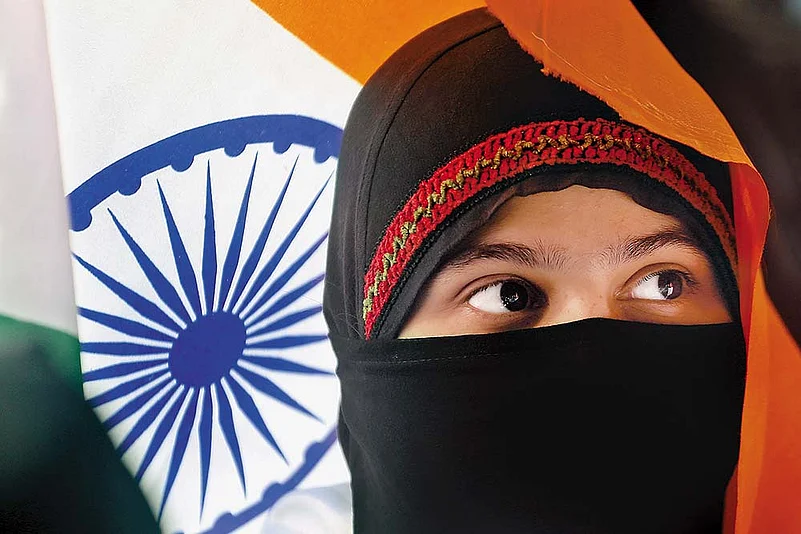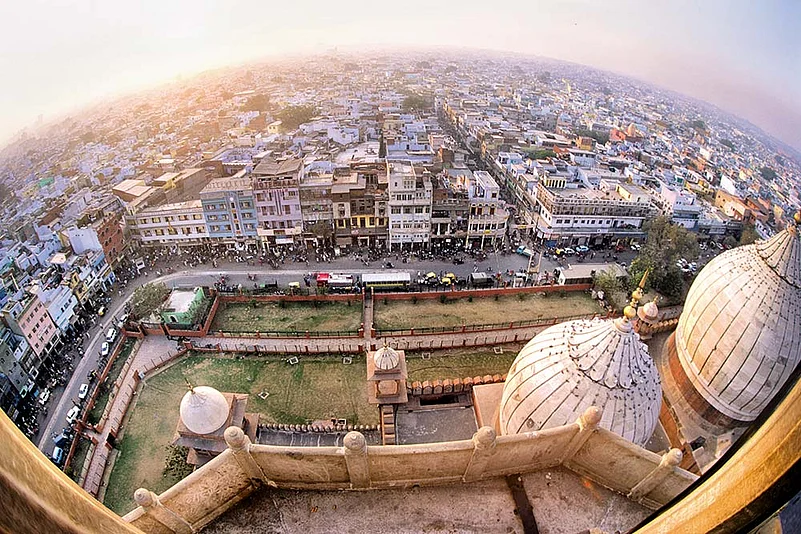Islam arrived in India from its classical origins in the Arabian lands via travels through Persia, Turkey, Central Asia and Afghanistan, acquiring a variety of accretions at each stage. And, having arrived, it accrued even greater variety through its regional dispersal (Punjabi, Bengali, Hindustani, Mappila, Gujarati, Odia…), and through a highly differentiated set of spiritual traditions of worship and scholarship that developed over some centuries. To name just a very miscellaneous few, there were figures of influence such as Shah Wali Allah of the Naqshbandi tradition located in the courtly ethos of princes, the more populist Chishti Sufi tradition consolidated by Shah Abdullah Latif Bhittai, Bulleh Shah, and the poets Mir and Dard, the reformist strain of Sir Syed Ahmad Khan; Chiragh Ali, the Shia thinker Ameer Ali, the novelist Nazir Ahmad, Shibli Nomani of the Nadwatul Ulema, the famous Deoband school providing traditional learning, the even more orthodox Ahl-i-Hadith school favouring strict Hanafi law, down to the more relaxed Barelwi tradition stressing very local customary practices, the Ahmadiyyas who claimed that their leader Mirza Ghulam Ahmad was all at once the Muslim Mahdi, the Christian Messiah and the avatar of Krishna, and in the 20th century the poet Muhammad Iqbal and the refined and learned Maulana Azad, representing in the last few decades of his life the ‘composite culture’ of Hindus and Muslims.
I begin with this remarkable accumulation of accretions that characterise Indian Islam not only to point out what is often said—that Islam is many things in India, not one—but also to point to the vast conceptual distance of the content of the Islam that laid these diverse roots in India from the originary Islam of the Arabian lands. As a result, any group trying to assert a fundamentalism of faith (Maulana Maududi and his following in the Jamaat-i-Islami, for instance) could do so only by deracinating itself from these roots, and their broad and entrenched range of practices, and by invoking in its place an Islam that—from the point of view of this pervasive and rooted Islam—is pure artifice, the rootless construct of a bookish, normative, deferential gaze upon some claims to an originary Islam of 7th-century Arabia.
But let me turn first to more recent times, as the editors of Outlook have asked me to speak in particular to the conditions of Muslims in our time.
It is widely known to all who have the capacity for honest perception ever since the hideous events of 2002 in Gujarat—and now the illegal interventions in Kashmir and the Citizenship (Amendment) Act, not to mention the brutality of authoritarian state violence against honourable dissent—that we are faced with a wilfully ruthless and oppressive regime, presiding over the dismantling of achievements (however partial and however qualified) built up over half a century of democratic legislation and institution-building. But these events of more recent years had their slow build-up since the late 1980s when Hindutva first emerged as a serious force in Indian public life and politics, and the effect it had on Muslims in that earlier period was far less stunning than it has been in the last decade. Proof of this lies in the fact that in the aftermath of the destruction of the Babri mosque in Ayodhya, Muslims showed some real agency and fought back. It is this agency that was (until these past two months) withdrawn for about a decade as Muslims sank into an understandable funk by the repeatedly stunning blows dealt by the fascist complexion that Hindutva acquired with the political rise of Mr Narendra Modi and Mr Amit Shah.

Mass-mobilised Muslims in Indian history never felt the tug of a sectarian aspiration.
All this is well known and plain to see. The interesting point, however, is that some of the agency Muslims showed after Ayodhya was deplorably violent, and even when it was not, much of it was voiced by leaders and organisations that sought to combat Hindu fundamentalism with fundamentalist Islamist claims, denying what Islam had come to be over centuries in the deep roots it lay in India. What is remarkable about the high visibility of Muslim voices in the protests and rallies of the last two months is that they have precisely eschewed that rootless doctrinal artifice, resorting to the rhetoric, the poetry, the creativity and the practices of a centuries-long Indian Islam, continuous with the Hindu, Sikh, Buddhist, Jain and other traditions in a pluralism that was unsettled for the first time by the acrimonies around Partition, and revived in a concerted way again only as late as the 1980s.
ALSO READ: Why No Shaheen Bagh In Kashmir?
What is even more significant, however, is that this appeal, unafraid to give voice to the commitments and practices of popular religion of that longstanding pluralist tradition, is being seamlessly integrated by the movements of the past two months—in a way that has never happened before—with the most abstract commitments of the codes, rights and provisions of the law and of the Constitution. No leader had managed to do this before in the history of 20th-century India. Gandhi, who almost single-handedly tapped the appeal of popular religion to generate the most prodigious of political mobilisations for some 30 years, also showed a studied indifference to the codes and rights that defined citizenship. He openly said at times that he did not think the heterogeneity of the people of India (in which he even sometimes included what he idealised naively as the more pure non-hierarchical differentiations allowed by the swadharma ideal of caste that were corrupted, as he insisted, by later developments that introduced hierarchy) should be undermined by making ordinary people over into some abstract, homogenous, codified form of being called ‘citizens’.
Nehru too had no inkling of how this integration might be made. The Nehru who wrote with deep affection in The Discovery of India of the un-self-conscious religious pluralism in Indian history entirely shifted gears when he articulated a very self-conscious set of secularist principles, which characterised the constitutional provisions that would, for instance, go into the formulation of the Hindu Code Bill. Nehru recognised the honour and worth in each, but in his thought these moved in different gears.
Ambedkar too had no integrating vision that joined the long egalitarian, anti-caste pluralist traditions of popular religion, going back to the early Varkaris and such figures as Kabir, with his own remarkable innovations in constitutional affirmative action to empower the deprived castes. In fact, I suspect that is why he was partly suspicious of the eventual efficacy of the anti-caste Bhakti ideals.
The integration I am speaking of is, thus, simply without precedent. It is being devised spontaneously, without the eminence of great leaders to shape it, and it is a remarkable achievement. In other words, these young men and women and the urban intelligentsia of large and small towns in India, though they are brilliantly effective activists, are much more than activists. They are, without any theoretical vanguard, fashioning through their struggles a theoretical framework that brings together practices and abstractions; and thereby instructing us into the habits and dispositions of democracy, which the Constitution’s abstractly formulated laws and principles always had as their deeper underlying historical source, and which were always formulated with a view to producing a cultivation and enactment of these habits and dispositions in the citizens of the future to whom they applied.
In this Muslim agency, embedded as it is in this particular integrated ideal of democracy I am emphasising, any Muslim voice that speaks with a fundamentalist strain sounds shrill and jarring, immediately inviting an internal correction. That is no small achievement. Hindu fundamentalism is being opposed by Muslims qua Muslims, not merely Muslims qua abstract citizens—but they are doing so by an insistent signing onto an abstract constitutional commitment to a secularist ideal of citizenship dictated to them from the point of view of reasons that flow from their own understanding of themselves as Muslims.
We can see through the filter of these contemporary mass mobilisations that display this complex integration a ¬retrospective illumination of a historical point of some importance. Though some have denied it (Perry Anderson’s sloppy invective is a conspicuous recent example of this), many would grant that Gandhi and Nehru genuinely sought a nationalism that was inclusive of Muslims. It must be granted at the same time, however, that the very fact of Partition amounted to a failure of that aspiration. We have long and incessantly reflected on this failure and sought a diagnosis for it. -Obviously, no short opinion piece can provide any such diagnosis, but one might find in what I have been describing about the present a very rough and general direction in which to seek it.
What is very striking is that whenever Muslims were included in the struggle for independence in mass movements—in the way that they ¬presently are as well—their involvement was wholeheartedly nationalist and anti-imperialist, not sectarian or communal. The Khilafat movement that mobilised the mass of Muslims qua Muslims, even though it did ¬eccentrically appeal to an obscure Muslim cause related to the end of the Ottoman Empire, was not only through and through a nationalist -mobilisation, it had dynamic effects in many regions of the country that made Muslims more progressive than they ever had been, both on gender issues and on issues of political economy that affected the peasantry. In fact, the more purely class struggle of the 1930s, over which the Congress did not always have control, could not have been possible without the antecedent inspirations of the Khilafat and non-cooperation mobilisations.
The effects of the Khilafat movement on Muslim consciousness had subsi¬ded by 1927-28 and there followed a decade in which Muslims were inclu¬ded in Indian nationalism by a quite different understanding of democratic inclusion—not via mass mobilisations, but more formal negotiations by its leaders with the Hindu leaders of the Congress in round table conferences and other such fora. In these more ¬formal efforts at inclusion, the Muslim leaders always felt alienated and dominated by their Hindu counterparts. So much so that Nehru explicitly declared in the late 1930s that it was a wholly wrong method of inclusive nationalism and one would have to return to a mass movement to include Muslims in the nationalist cause. It was with such a declared understanding that the Muslim Mass Contact Campaign was launched by the Congress under the leadership of the left-leaning Muslim leader K.M. Ashraf, and it was through these campaigns that a wide range of Muslims were brought again into the anti-imperialist nationalist ¬campaign—the Khudai Khidmatgars, the Aligarh academics, many of the Deobandi leaders….
The campaign was shorter-lived than the Khilafat movement and never ¬really reached deep into the peasantry as the earlier campaign had. Still, these points, I believe, bring out something that the present campaigns in the squares and maidans are retrospectively making clear. The failure of Partition was the failure of formal methods of inclusion through negotiations between leaders. When ordinary Muslims had a genuinely participatory role in mass mobilisations, they never felt the tug of a sectarian, communal or separatist aspiration.
Let us hope, then, that leaders don’t enter and ruin the political possibilities of resistance that have emerged in the participatory presence of Muslim women and men in the morale-boosting mass mobilisations that we are currently witnessing.
(Views are personal)
Akeel Bilgrami, Sidney Morgenbesser Professor of Philosophy and professor, Committee on Global Thought, Columbia University
















